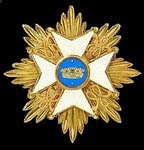I have now added uniform plates to all three of the Prussian garrison regiment posts. The uniforms of the garrison regiments were generally much simpler and plainer than those of the line regiments, largely for reasons of economy. The Prussian state always struggled to support what was, compared to its population, a very large standing army. In wartime, looting occupied countries, as the Prussians ransacked Saxony in the Seven Years War, often brought in much needed revenue to keep the Prussian war machine functioning.
Saturday, 9 August 2014
Uniform plates added to all three Prussian garrison regiment posts...
Posted by
David Morfitt
at
Saturday, August 09, 2014
6
comments
![]()
Friday, 8 August 2014
Flags of Prussian Garrison Regiment II
In 1757 the regiment was in the second line at the battle of Gross-Jägersdorf on 30th August and suffered heavy casualties; according to Engelmann, "in the thick Norkitt Forest, amid powder smoke and battle noise, it began to shoot at its own first line by mistake, taking them for the Russians. This confusion made the Russian counterattack possible". It was at Schweidnitz in 1758 and the grenadiers saw action at Zorndorf (over 30% casualties - Duffy), Kay and Kunersdorf (around 30% casualties - Duffy). From 1760 the 1st battalion was with Prince Henry in Silesia and Saxony. The other battalions were firstly at Breslau and Neisse, then Neisse, Trachenburg and Militsch in 1762. The 1st battalion and grenadiers fought in the battle of Torgau in 1760, as well as at Freiberg in 1762. The regiment retained 3 battalions at the peace in 1763 unlike the other garrison regiments that returned to their pre-1756 establishment.
This is the most elaborate style of garrison regiment flag, carried only by regiments 1 and 2. It is very similar to the flags carried by many of the regular line infantry regiments, except for the wreaths which are in the style carried by the other garrison regiments and which are very similar to the design of wreath used on the flags of the regiments of Frederick William I, Frederick's father. The regimental flag design is shown at the top (Kompaniefahnen), the Colonel's flag (or Leibfahne) at the bottom.
And this plate shows the relatively plain uniform of the regiment, typical of those of the garrison regiments:
(I shall shortly add uniform plates for the other two garrison regiments whose flags I have depicted.)
Posted by
David Morfitt
at
Friday, August 08, 2014
4
comments
![]()
Tuesday, 5 August 2014
Flags of Prussian Garrison Regiment V
Garrison Regiment V was raised as a garrison for the newly captured fortress of Glogau in 1741. At first of 2 battalions, it was increased to 4 in 1754. (It is reported that the increase included many men drafted from other Silesian regiments, of normal height "but who are vagabonds and of whom the regiment is not really sure" - Engelmann, Infantry of Frederick the Great.) It was recruited in Glogau until 1747 when its recruiting area was increased to include Breslau and Frankenstein (yes, there really is (or was) a place called Frankenstein!*). The regiment garrisoned not only Glogau but by 1755 Crossen, Reppen, Züllichau, Beeskow and Sommerfeld.
It had a very eventful Seven Years War, especially for a unit designated for garrison duties. The 1st and 2nd battalions were part of a small Prussian force which was designed to push the Austrians out of Landeshut and were at the first battle of Landeshut in August that year. In November 3 battalions were captured when Schweidnitz fell to the Austrians. In April 1758 the 1st and 2nd battalions were part of the King's army which recaptured Schweidnitz and were subsequently in June part of the guard of the supply train that was destroyed at Domstadl during the invasion of Moravia and unsuccessful siege of Olmütz. The 1st and 2nd battalions were then at the battle of Paltzig (or Kay) in July 1759, where the Prussians were defeated by the Russians, and then had the pleasure of facing the Russians again at Kunersdorf in August, another bloody defeat for the Prussians in the face of a combined Austro-Russian army. (The 1st edition of Christopher Duffy's Army of Frederick the Great shows that Garrison Regiment V's 2 battalions suffered 20-25% casualties at Kunersdorf, serious losses but probably a good deal fewer than many of the other Prussian regiments involved.) In 1760 they joined Prince Henry's army and stayed on in Saxony. The 3rd and 4th battalions spent most of the war in garrison duties in Silesia, no doubt much to the relief of the troops, especially when they heard of the experiences of the 1st and 2nd battalions!
This was the simplest design of garrison regiment flag, carried by the majority of the garrison regiments. The regimental flag design is shown at the top (Kompaniefahnen), the Colonel's flag (or Leibfahne) at the bottom.
* A quick check on the 'Net shows that Germany still has several, in fact...
Posted by
David Morfitt
at
Tuesday, August 05, 2014
2
comments
![]()
Monday, 4 August 2014
Flags of Prussian Garrison Regiment III
Some years ago I posted simple outline templates of the flags of various Prussian regiments, including some of the Garrison Regiments. I thought I'd update some of them as colour versions and here are the first updated flags.
Garrison Regiment III was raised as a single battalion in 1718 for garrison duty. It was recruited in Pomerania - the towns of Colberg, Bublitz, Usedom and Bütow. An additional battalion was raised in 1757, making it a full regiment. At the start of the Seven Years War it was the garrison of Colberg. Its grenadiers (combined with those of Garrison Regiment IV and the New Garrison regiment) fought at Prague, Kolin, Schweidnitz, Leuthen, Hochkirch and Torgau. In 1758 and 1759 the musketeer battalions occupied Torgau and Dresden. In September 1760 the first battalion was taken prisoner in Torgau and the second battalion was taken prisoner in Wittenberg in October that year. The regiment was reformed at the end of the war in Colberg in 1763, incorporating men from Schony's Frei Korps as well as returning former prisoners.
The regimental flag design is shown at the top (these were the Kompaniefahnen), the Colonel's flag (or Leibfahne) at the bottom.
Posted by
David Morfitt
at
Monday, August 04, 2014
10
comments
![]()























